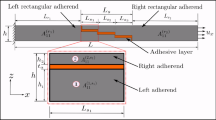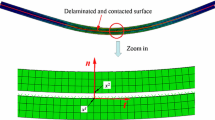Abstract
Adhesively bonded sandwich structure with dissimilar materials becomes an important means of lightweight for the next generation of autobody closure panels. However, during the baking process, the complicated change of physical properties of the adhesive can lead to structural mismatch deformation. In this paper, a multi-physics coupling numerical model of the curing process is proposed to reveal the deformation mechanism of adhesively bonded sandwich structures quantitatively. The material constitutive model of the one-component hemming adhesive hemming adhesive is established, considering evolution of curing properties. The curing process of typical aluminum alloy and steel-bonded sandwich structure is simulated in COMSOL Multiphysics. The predicted surface deformation of the component is verified by experiment using Digital Image Correlation (DIC) technique, which captures the full-field displacement in a non-intrusive manner. Then, the development process of surface deformation of the outer panel and residual internal stress of the adhesive layer is analyzed, and the influence of temperature cycle on the maximum deformation of the component is discussed. The results show that at the beginning of holding stage, the deformed component slightly rebounds, which is related to the chemical shrinkage. Mechanical strain caused by the coefficient of thermal expansion (CTE) and stiffness difference of the inner and outer panels is dominant in the adhesive layer. Reducing the curing rate and maximum holding temperature can reduce the overall deformation of the structure.















Similar content being viewed by others
Availability of data and material
The raw/processed data are available from the corresponding author on reasonable request.
Code availability
The software application/custom code is available from the corresponding author on reasonable request.
References
Martinsen K, Hu S, Carlson B (2015) Joining of dissimilar materials. Cirp Ann-Manuf Tech 62:679–699. https://doi.org/10.1016/j.cirp.2015.05.006
Baneaa M, Rosioarab M, Carbasb R, Silva L (2018) Multi-material adhesive joints for automotive industry. Compos Part B-Eng 151:71–77. https://doi.org/10.1016/j.compositesb.2018.06.009
Hu P, Han X, Li W, Shi Z, Zhou S (2012) Influence of automobile body coating process on the strength of unbalanced adhesive joints. Chin J Mech Eng 48(20):93–102. https://doi.org/10.3901/JME.2012.20.093
Hu X, Zhao Y, Huang S, Li S, Lin Z (2012) Numerical analysis of the roller hemming process. Int J Adv Manuf Technol 62(5–8):543–550. https://doi.org/10.1007/s00170-011-3822-4
Xin W, Hao H, Zhang G, Cindy R (1999) Variation in autobody adhesive curing process. International Congress and Exposition Detroit, Michigan, 01-0997. https://doi.org/10.4271/1999-01-0997
Zhu X, Li Y, Chen G, Wang P (2013) Curing-induced distortion mechanism in adhesive bonding of aluminum aa6061-t6 and steels. J Manuf Sci E-T ASME 135:051007. https://doi.org/10.1115/1.4025013
Silva L, Adams R (2007) Adhesive joints at high and low temperatures using similar and dissimilar adherends and dual adhesives. Int J Adhes Adhes 27:216–226. https://doi.org/10.1016/j.ijadhadh.2006.04.002
Andersson A (2009) Evaluation and visualisation of surface defects on auto-body panels. J Mater Process Tech 209:821–837. https://doi.org/10.1016/j.jmatprotec.2008.02.078
Fernholz K, Blair B, Wang C, Lazarz K (2008) Bond-line read-through investigation for composite closure panels: initial doe results. SPE Automotive Composites Conference, Troy, MI
Fernholz K, Lazarz K, Wang C (2009) Preliminary results from an experimental evaluation of the root causes of bond-line read-through. The Adhesion Society 32nd Annual Meeting, Savannah, GA, pp 285–287
Fernholz K, Lazarz K (2010) Effect of cure temperature on the severity of bond-line read-through induced surface distortion. The Adhesion Society 33rd Annual Meeting, Daytona Beach, FL, pp 211–213
Basu S, Kia H (2008) Theoretical modeling of bond-line read-out in adhesive joined SMC automotive body panels. J Compos Mater 42:539–552. https://doi.org/10.1177/0021998307088604
Patankar K, Dillard D, Fernholz K (2013) Characterizing the constitutive properties and developing a stress model for adhesive bond-line readout. Int J Adhes Adhes 40:149–157. https://doi.org/10.1016/j.ijadhadh.2012.07.006
Fuchs H, Fernholz K, Deslauriers P (2010) Predicted and measured bond-line read-through response in composite automotive body panels subjected to elevated temperature cure. J Adhesion 86:982–1011. https://doi.org/10.1080/00218464.2010.515471
Zhou L, Lin G, Jack S (2008) Modeling of curing-induced distortion of adhesive-bonded joints. Proceedings of the 8th Sheet Metal Welding Conference, Sheet Metal Welding Conference XIII, Livonia, MI
Konstantin P, Jos S, Rinze B (2014) Influence of the temperature cycle on local distortions in car panels caused by hot curing epoxies. Int J Adhes Adhes 50:216–222. https://doi.org/10.1016/j.ijadhadh.2014.01.035
Adolf D, Martin J (1996) Calculation of stresses in crosslinking polymers. J Compos Mater 30:13–34. https://doi.org/10.1177/002199839603000102
Kiasat M (2000) Curing shrinkage and residual stresses in viscoelastic thermosetting resins and composites, Doctoral dissertation, Delft University of Technology
Eom Y, Boogh L (2000) Time-cure-temperature superposition for the prediction of instantaneous viscoelastic properties during cure. Polym Eng Sci 40:1281–1291. https://doi.org/10.1002/pen.11256
Ding A, Li S, Sun J, Wang J, Zu L (2016) A thermo-viscoelastic model of process-induced residual stresses in composite structures with considering thermal dependence. Compos Struct 136:34–43. https://doi.org/10.1016/j.compstruct.2015.09.014
Vreugd J (2011) The effect of aging on molding compound properties. Doctoral dissertation, Delft University of Technology
Konstantin P, Jos S, Rinze B (2014) On the simulation of panel distortions due to hot curing adhesives. Int J Solids Struct 51:2470–2478. https://doi.org/10.1016/j.ijsolstr.2014.03.016
Jansen K, Vreugd J, Ernst L (2012) Analytical Estimate for curing-induced stress and warpage in coating layers. J Appl Polym Sci 126:1623–1630. https://doi.org/10.1002/app.36776
Vreugd J, Jansen K, Ernst L, Bohm C (2010) Prediction of cure induced warpage of micro-electronic products. Microelectron Reliab 50(7):910–916. https://doi.org/10.1016/j.microrel.2010.02.028
Yan X (2010) Fintie element modeling of curing of epoxy matrix composites. J Appl Polym Sci 103(4):2310–2319. https://doi.org/10.1002/app.24337
Li D, Li X, Dai J (2018) Process modelling of curing process-induced internal stress and deformation of composite laminate structure with elastic and viscoelastic models. Appl Compos Mater 25:527–544. https://doi.org/10.1007/s10443-017-9633-5
Kissinger H (1957) Reaction kinetics in differential thermal analysis. Anal Chem 29:1702–1706. https://doi.org/10.1021/ac60131a045
Málek J (1992) The kinetic analysis of non-isothermal data. Thermochim Acta 200:257–269. https://doi.org/10.1016/0040-6031(92)85118-F
Ernst L, Hof C, Yang D, Kiasat M, Zhang G, Bressers H, Caers J, Boer A, Janssen J (2002) Mechanical modeling and characterization of the curing process of underfill materials. J Electron Packaging 124:97–105. https://doi.org/10.1115/1.1459471
Yang D, Jansen K, Ernst L, Zhang G, Janssen J (2007) Effect of filler concentration of rubbery shear and bulk modulus of molding compounds. Microelectron Reliab 47:233–239. https://doi.org/10.1016/j.microrel.2006.09.031
Li Y, Mahmood S, Park C (2016) Visualization for measuring the PVT property of viscoelastic polystyrene/CO2 mixtures at elevated temperatures and pressures. Polym Test 55:88–96. https://doi.org/10.1016/j.polymertesting.2016.08.010
Zarrell M, Skordo A, Partridge I (2002) Investigation of cure induced shrinkage in unreinforced epoxy resin. Plast Rubber Compos 31:377–384. https://doi.org/10.1179/146580102225006350
Senum G, Yang R (1977) Rational approximations of the integral of the Arrhenius function. J Therm Anal Calorim 11:445–447. https://doi.org/10.1007/BF01903696
Ke L, Li C, He J, Dong S, Chen C, Jiao Y (2020) Effects of elevated temperatures on mechanical behavior of epoxy adhesives and CFRP-steel hybrid joints. Compos Struct 235:111789. https://doi.org/10.1016/j.compstruct.2019.111789
Funding
This research was supported by the NSFC-China (National Natural Science Foundation of China) Project (No. 51975416 and No. 51275359).
Author information
Authors and Affiliations
Contributions
JianJun Li completed the simulation and experiment analysis and wrote the manuscript. WenFeng Zhu was in charge of research method and framework of the whole manuscript. Yuanhui Li and Genglin Tang assisted in literature investigation and experiment. All authors read and approved the final manuscript.
Corresponding author
Ethics declarations
Conflict of interest
The authors declare no competing interests.
Additional information
Publisher's Note
Springer Nature remains neutral with regard to jurisdictional claims in published maps and institutional affiliations.
Rights and permissions
About this article
Cite this article
Li, J., Zhu, W., Li, Y. et al. Numerical study on curing-induced residual stress and deformation of adhesively bonded sandwich structures of dissimilar materials. Int J Adv Manuf Technol 120, 1189–1201 (2022). https://doi.org/10.1007/s00170-021-08480-7
Received:
Accepted:
Published:
Issue Date:
DOI: https://doi.org/10.1007/s00170-021-08480-7




